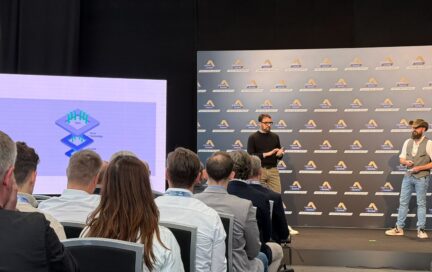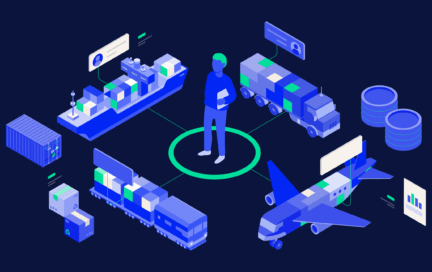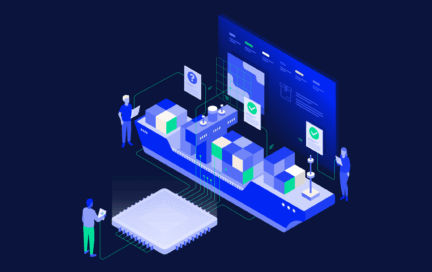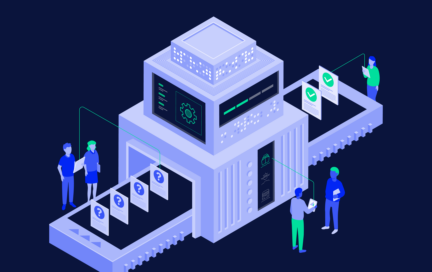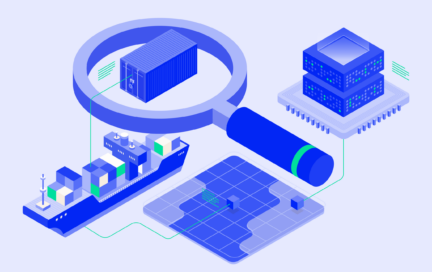Recently, the logistics sector has witnessed a surge of firms claiming to revolutionize supply chain management with a diverse set of AI-powered applications. At Forto, we recognize these advancements, yet we’re convinced that the real power of AI in logistics goes beyond just using ready-made solutions. It’s about strategically building data science know-how within the organization and combining operational human expertise in the domain with the latest technologies through a framework that allows swift validation of newly developed solutions. This might sound obvious for many sectors, but in an operations-heavy and relatively traditional business such as logistics, the solution in hand has to properly account for the current human and ecosystem constraints.
In 2023, encouraged and excited by the capabilities of Generative AI (GenAI), we revised and accelerated Forto’s AI strategy. We organized knowledge sharing sessions for Forties (that’s what we call ourselves at Forto) to elevate everyone’s understanding of GenAI beyond the fun of playing with ChatGPT and Dall-E, conducted cross-functional workshops to ideate on problems that the new capabilities have the potential to address, and developed proof-of-concepts anchored around understanding the opportunities and limitations of GenAI.
This post is the first of its kind to share our journey, learnings and results as we just embark on an exciting year at Forto.
Is Generative AI the silver bullet?
The developments around GenAI are groundbreaking and inspiring, yet, for us, it’s imperative to understand its limitations and applicability to the problems of the logistics industry. In one sentence, GenAI excels at extracting insights and trends from vast pools of information, which in turn can enable the generation of high-quality outputs when purposefully prompted.
In transport management, the technology could play a key role in scaling automation, enhancing the quality of transport data, and elevating service quality. However, to tackle the nuanced intricacies of logistics and address longstanding challenges in supply chain management, we believe that a comprehensive approach is needed beyond just betting on the current capabilities of GenAI.
“What is your plan for leveraging the potential of GenAI?” This has been the question at every board meeting of the past year, at Forto as well as in the boardrooms of almost every company that builds or procures technology. Behind this question is the sense of awe and curiosity that followed widespread access to applications like ChatGPT and Dall-E. However, at Forto, we firmly believe that the more pertinent question should be: “How can your AI strategy evolve to harness the transformative power of GenAI?” That was the question we addressed in the second half of 2023!
Forto’s approach to AI in logistics
It is a fact that logistics is a document-heavy sector that requires a fragmented partner landscape to continuously exchange information as goods move from an origin to a destination. The documentation needs and requirements of the industry are diverse, with content and format barely standardized, often multilingual, and, in many cases, legally mandated. The volume and complexity of document-based data exchange are among the primary reasons for the industry relying on manual document analysis, data extraction, and input entry into various systems. The obvious elephant in the room that created this juggernaut is the lack of standard or scalable means of exchanging data across the partner and vendor ecosystem, as APIs barely exist or were adopted in this sector.
In 2023, we prioritized three separate high-impact and priority problems to go after. Perhaps you can guess the initial use case that we decided to tackle. In mid-2023, we decided to take on a mission to automate all document-based processes by harnessing the power of GenAI. As we progressed in the validation of our proof-of-concepts, it was clear that all promising solutions required chaining various other technologies, in most cases other AI-based technologies, to address the problem at hand.
Data extraction from documents with AI
As I mentioned earlier, in operations, a significant amount of time is consumed in handling various types of documents that reach Forto. These documents are generally sent as email attachments or document uploads to our portal. Moreover, the email body often has supplementary context in relation to the documents that Forto needs to extract information from.
Our solution? Deploying a solution that combines GenAI, fuzzy matching, computer vision and robotic process automation (RPA). The solution is built to categorize the document types, understand the context of the email body, extract the data fields from any types of attachments, map them to our data model and then ingest the data into our system. And repeat the process thousands of times a day.
Results driving impact – How does it work?
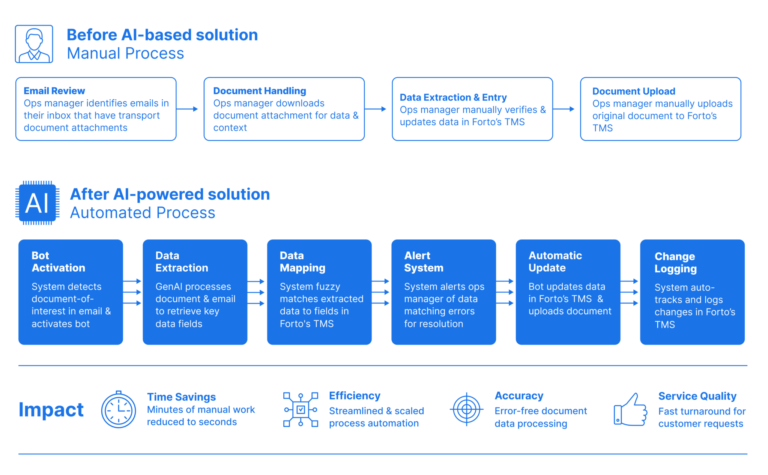
As we roll out the first version of the solution, the system handles over 1,000 documents of various types every day with no human intervention, understanding and extracting meaning from over 50,000 data points daily across emails and document attachments within seconds.
As a specific example, the handling of arrival notices, which is a key shipment document, used to consume hours from our teams, which is now reduced to mere milliseconds with 100% accuracy. As a result, we have not only managed to save hundreds of operational hours per month over a single document type but also enabled the confirmation of shipment details with the customers in near real-time, which has been a key value driver for the Moments of Truth program.
The above numbers are based on a single type of document. Across all document types that this single solution is handling, we foresee an operational efficiency gain of 10% at scale. With these results, from where we stand, the future seems to be super bright!


